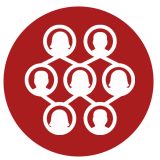A review of current communications showed inconsistencies in the use of language from a gender perspective including frequent use of masculine nouns for both genders.
Reviewing institutional documents: revision of any text, communication, images, from a gender equality and diversity standing point and provision of relevant training
Problem (evidence)
Aims/objectives
To use inclusive language in our communication.
Resources
A person with expertise in the gender inclusive language.
Budget to be allocated to this task and human resources.
Brief outcomes
Guidelines on gender-sensitive language use are available for all staff. Any non-gender sensitive language, when pointed out, was immediately corrected.
So far, the reactions to any official emails stating that the use of language could be more inclusive have been positive and a promise was made that the language will become more gender inclusive.
Key area
The governance bodies, key actors and decision-makers
Type of action
Data gathering and analysis
Organization
Kemijski Inštitut, National Institute of Chemistry
Research institute
Action level of implementation
Researchers/professors and technical and administrative staff
Implementation
We first trained Human Resources (HR), Public Relations (PR) and Project Office (PO) staff on gender inclusive language. We organized 2 courses for HR and PR and PO departments. The first one was led by Dr. Klanjšek Gunde who has already been trained due to her active role in the Commission for Women in Science. The second course was led by the European translation agency and the Ministry of Labour, Family, Social Affairs and Equal opportunities which also has gender equality policy.
In late 2018 – early 2019, we continued the practice of random sampling of texts used for internal and external communication. We used a random sample of documents, twitter and FB posts, vacancy and public announcements by the Institute as we could not review every communication due to its sheer size. Any use of language / visual material that was not inclusive was pointed out to the author of the text with the suggestions on how to improve it. This has, in the first instance, been applied to the annual report of NIC, then to public invitations for stipends.
The guidelines were provided to PLOTINA project team and then distributed to all employees and also to the outside mailing list of PLOTINA.
Two PLOTINA project members also participated in the preparation of the Gender inclusive language guidelines. These were distributed by the PLOTINA members at PLOTINA stands in their physical form, and the electronic version has been published on NIC’s PLOTINA page. Also, in the same location, we invited anybody to point out any inappropriate use of language.
Members of the PLOTINA team in their everyday communication use gender inclusive language and point out any obvious inconsistencies of which they become aware, for example in announcements of events, posting posts, official announcements.
Challenges
This action is quite time consuming and it is a large extra task for existing staff, so based on our experience we would suggest recruiting outside experts to assist with this. Due to the sheer size of the material produced at NIC, it is impossible to check every text.
Also, if you constantly correct people for their use of language, it can be frustrating and upsetting. However, anecdotally it seems to improve. In addition, it also encourages people to reflect on how to make their communication more inclusive.
The Slovenian language has a duality aspect which makes gender neutral language difficult to achieve. However, we are aware that language is a reflection of culture too, so we are persevering in this matter because culture change takes time.
Coping strategies
We focused on a fairly random selection of communication and communicated our findings with the people involved (PR, editors of the annual report etc). We prioritised external communication.
More detailed Outcomes/Impact
We hope that the use of more inclusive language will contribute to a culture change in the institution and a better gender balance among researchers in senior career grades.
Tips/strategies – Lessons learnt
It is good to identify the editors of most public texts (in our case, this is the PR office) – to train first those who communicate most with the public.
Reflection: what we would do differently
Putting the question “Did you encounter any use of gender insensitive language?” on the webpage with invitation to contact the PLOTINA email, led to no response. NIC researchers are more responsive when approached in person than in any other way.
Unintended consequences
The exhibits in the hall leading to the director’s office were changed: we now have gender-balanced art exhibitions displayed at the institute.


